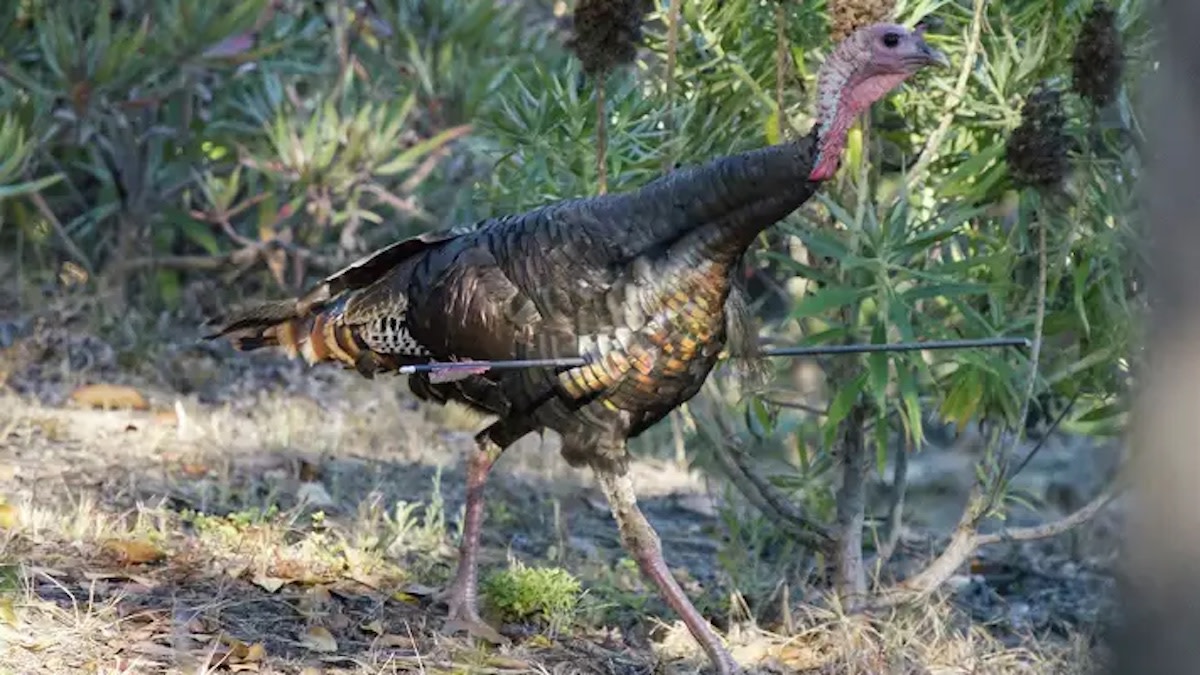
A wild turkey with an arrow protruding through its chest has been living life as usual around Carmel, California, for the past few months.
The turkey, dubbed “Cupid” by locals, seems unfazed by the injury. First spotted last winter, the turkey has been recorded multiple times by several different people. The photos and videos capture it going about his turkey business as would be expected, roosting in trees, foraging for grubs, and evading predators, except that it's doing so with a 30-inch arrow impaled horizontally straight through its chest cavity, sticking out on both ends.
Wildlife photographer Guy Churchward was one of the first to get photos and footage of the resilient bird, which he posted to YouTube on July 29.
“A turkey with an arrow—I thought was the oddest thing,” Churchward said. “I immediately jumped out of my car to take a photo.”
Cupid’s Plight
Churchward heard of the bird at a holiday party the year prior. Since locating it, he’s led local wildlife agencies and the SPCA to come help and offered to donate money or supplies to help capture and treat the bird. But experts say the risks of capturing and treating the injury outweigh the potential benefits.
Beth Brookhouser, a spokesperson for the Society for the Prevention of Cruelty to Animals Monterey County, said that because the turkey is otherwise healthy and mobile, the risks of capture are far higher than the risks it faces remaining in the wild. The SPCA’s plan is to continue to monitor the situation, adding that it appreciates updates on the bird’s health and location.
Concerned citizens around Big Sur have been monitoring its whereabouts, exchanging information on community message boards. The arrow doesn’t seem to impede movement—this turkey spends its time across two sprawling planned communities, and more than 2,000 acres, in the hills just north of Big Sur.
Rebecca Dmytryk, the director of Wildlife Emergency Services, a private volunteer group based in California’s central coast, believes that “Cupid” is a hen, based on the length and color of the beard, while others think that it’s a Jake the Guardian reports.
Brookhouser added that the turkey is still accepted by their flock and that no humans have been successful in getting within 20 yards of them. “We don’t know how the turkey evaded death with this one,” Brookhouser said, calling the bird, “incredibly lucky and very resilient.”
Turkey hunting is illegal in the area, so local officials are seeking more information about who let the arrow in question fly.
Other Impaled Avians
This isn’t the first bird to be spotted with an arrow living like this.
Earlier this summer, another turkey, a tom near Fort Collins, Colorado, was living with an arrow sticking out of its body. In Homer, Alaska, a sandhill crane, that was shot with an arrow through the breast and out the wing, was still walking around as usual and feeding its colts.
In 1822, an impaled bird provided the first real evidence of migration when a white stork returned to Western Europe with an iron-tipped wooden spear from Central Africa. Being literal people, the Germans gave this stork a new name, Pfeilstorch, meaning arrow-stork, (and quickly took it out with another arrow). Before this discovery, many experts still believed birds hibernated, metamorphosed, or surmised some other explanation—in 1703 a Harvard professor actually proposed that birds were flying to the moon.




